The Story of the Los Angeles Aqueduct
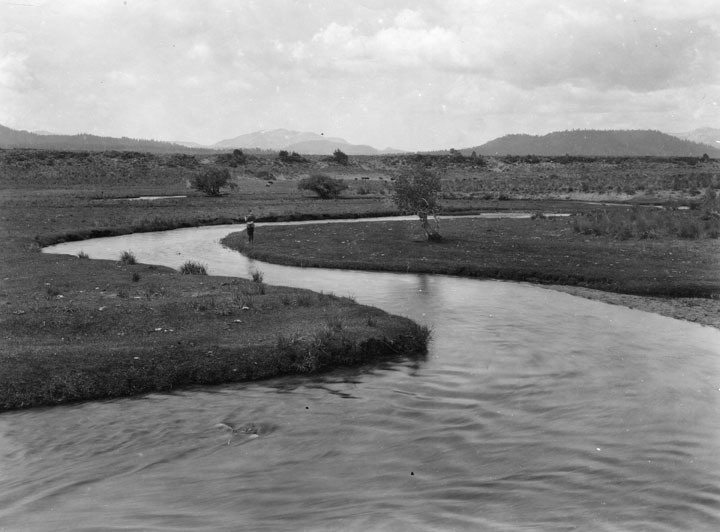 |
|
| (1912)* - View showing a lone fisherman along the banks of the Owens River. |
Historical Notes The Owens River is located in southeastern California and is approximately 183 miles long. It drains into and through the Owens Valley, an arid basin between the eastern slope of the Sierra Nevada and the western faces of the Inyo and White Mountains. The river terminates at Owens Lake, but its flow has been greatly diminished by diversion into the Los Angeles Aqueduct since 1913. |
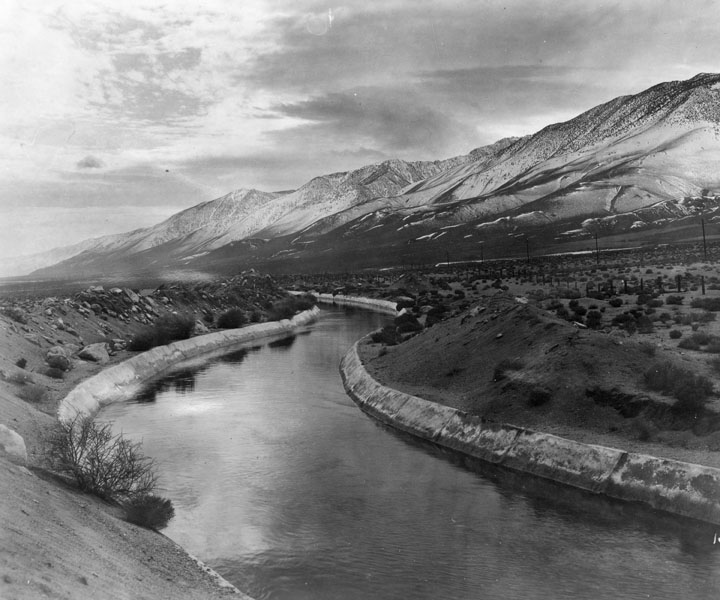 |
|
| (1928)* - Panoramic view of the Los Angeles Aqueduct in the Owens Valley near Alabama Hills on November 24, 1928. |
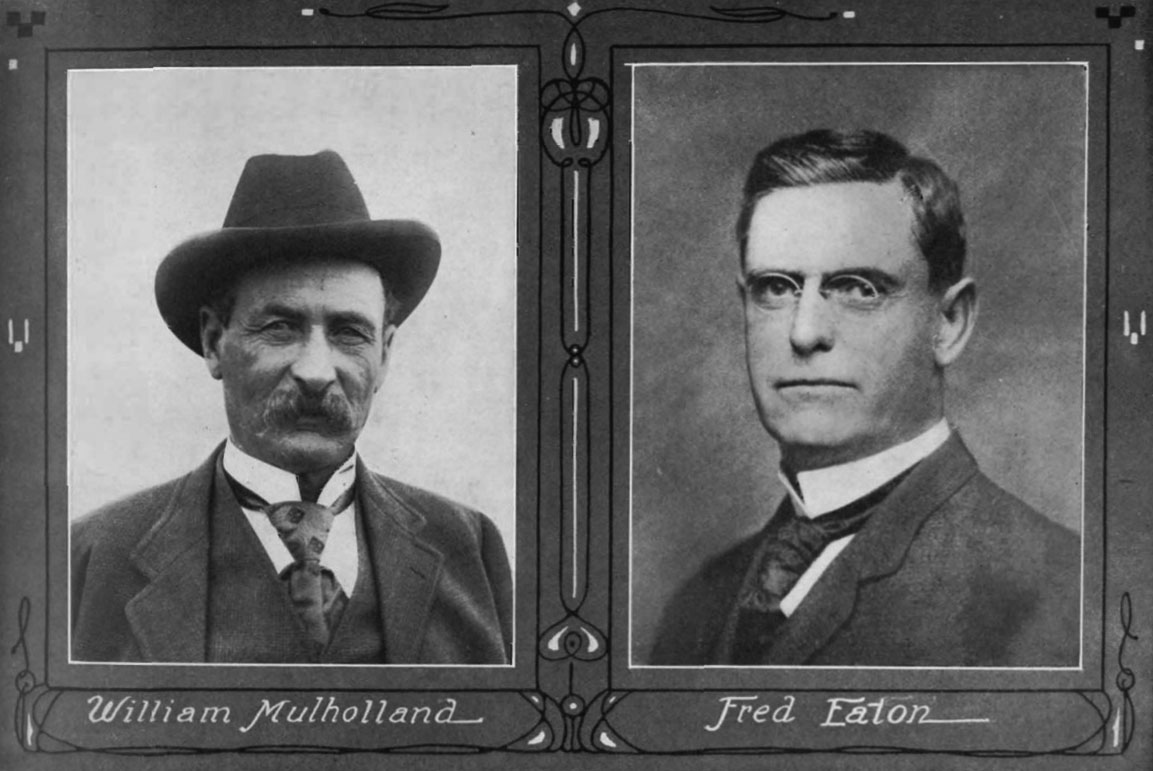 |
|
| (1913)^# – Portrait photographs of William Mulholland and Fred Eaton |
Historical Notes In 1904, Fred Eaton and J. B. Lippincott traveled to Yosemite Valley on a family camping trip. They crossed the Sierra at Tioga Pass and headed south to Bishop for supplies, and eventually back to Los Angeles through the Owens Valley. During that trip Eaton began making plans that would bring water to a growing city and launch a long conflict. Upon his return to Los Angeles, Eaton began to act quickly. Aware that Mulholland was searching for a new source of supply for Los Angeles, Eaton persuaded Mulholland to return to the valley with him. During that trip he convinced Mulholland that the Owens River could provide Los Angeles with a reliable source of water. Eaton visited the Owens Valley again in 1905 and began to purchase land for the City of Los Angeles. He gave the impression that he was working for the US Reclamation Service on a public irrigation project, angering local residents when they discovered he was buying land and water rights for Los Angeles. Click HERE to read more about 'The Three Fathers of the Los Angeles Aqueduct'. |
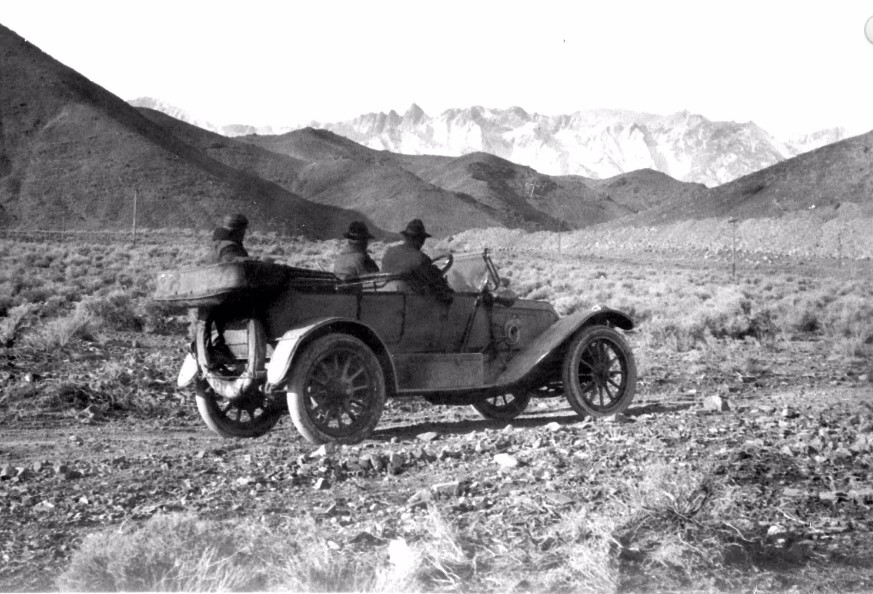 |
|
| (ca. 1907)^*– View showing William Mulholland along with two others, sitting in a car in the Owens Valley. All three are looking toward the snow covered Eastern Sierras, water source of the yet to be built L.A. Aqueduct. |
Historical Notes In March of 1905, Mulholland recommended to the Board of Water Commissioners that the Owens Valley was the only viable source of supplemental water for the City’s fast growing population. The following year the City submitted an application for rights-of-way across federal lands for the purpose of constructing an aqueduct. The application was approved and in 1907 Los Angeles voters approved a $23 million bond issue for the construction of the Los Angeles Owens Valley Aqueduct. Work began on the aqueduct in September and the City began to purchase private property and water rights in the southern pert of Owens Valley. |
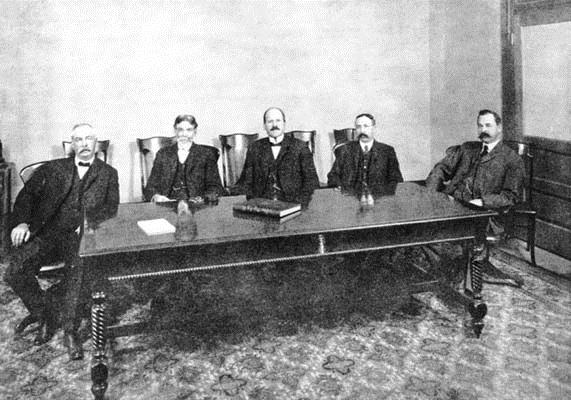 |
| The Board of Water Commissioners of the LA Department of Water and Power at the time of the building of the LA Aqueduct to Owens Valley. (L-R) John J. Fay, J. M. Elliott, Moses H. Sherman, William Mead, and Fred L. Baker. |
Historical Notes Moses Sherman served on the water board while he also participated in plans to develop the San Fernando Valley, which became the outlet point for the aqueduct. Sherman's double role has been the source of conspiracy theories with regard to the aqueduct. |
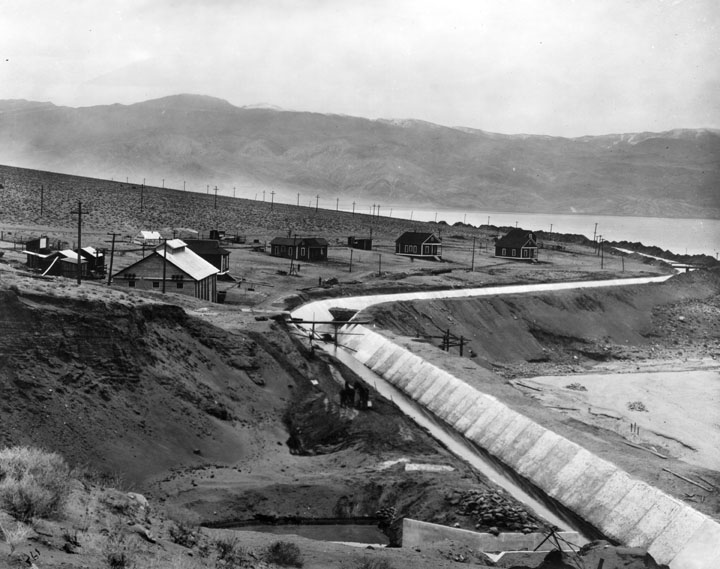 |
|
| (ca. 1911)* - Owens Valley during the planning and construction period of the Los Angeles Aqueduct. In this view, the aqueduct skirts around Owens Lake, a "dead sea," with no outlet to the ocean. |
Historical Notes After securing the land and water rights, the Board of Water Commissioners needed to obtain the money from Los Angeles residents, and legal rights from the Federal Government, to construct the aqueduct. A bond measure to pay for the construction passed in Los Angeles by a 10 to 1 margin. After much debate in the House of Representatives, President Theodore Roosevelt decided that Los Angeles should have the rights to the Owens River water. |
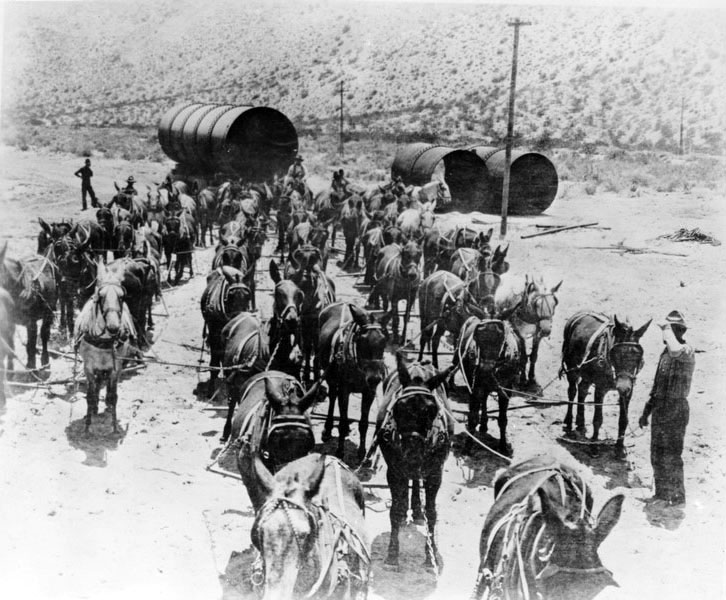 |
| (1912)* - Transportation was largely by mule power when the Los Angeles Aqueduct was under construction. This photo shows a 52-mule team hauling sections of aqueduct pipe. Work on the aqueduct was started on September 20, 1907. |
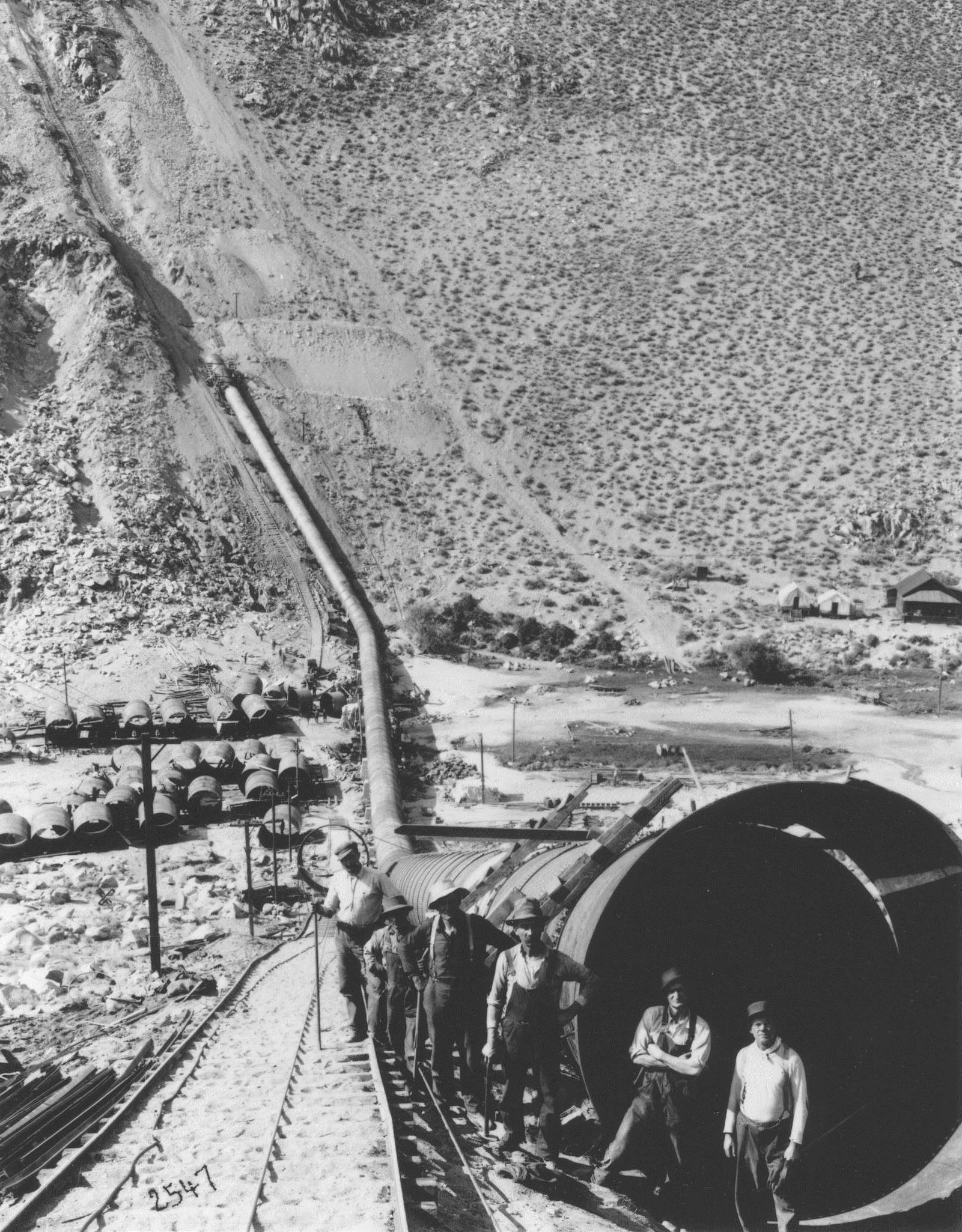 |
|
| (ca. 1912)* - A view of workmen posing in front of a new section of the aqueduct pipeline. |
Historical Notes Construction on the Los Angeles Aqueduct began in 1907. Workers from all over the world came to work at high-paying jobs that would last until 1913. |
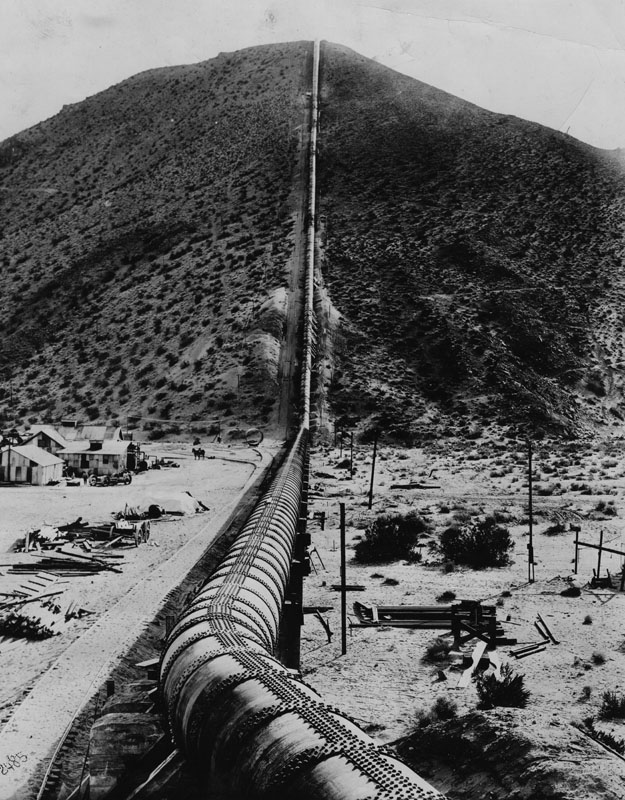 |
|
| (ca. 1912)* - Caption reads: The famous Jawbone siphon of the Los Angeles Owens River aqueduct, built by William Mulholland, which crosses two mountain ranges and the Mojave Desert to bring the city its water supply from the snow-capped High Sierras--a 250-mile journey. |
Click HERE to see more on the Construction of the LA Aqueduct. |
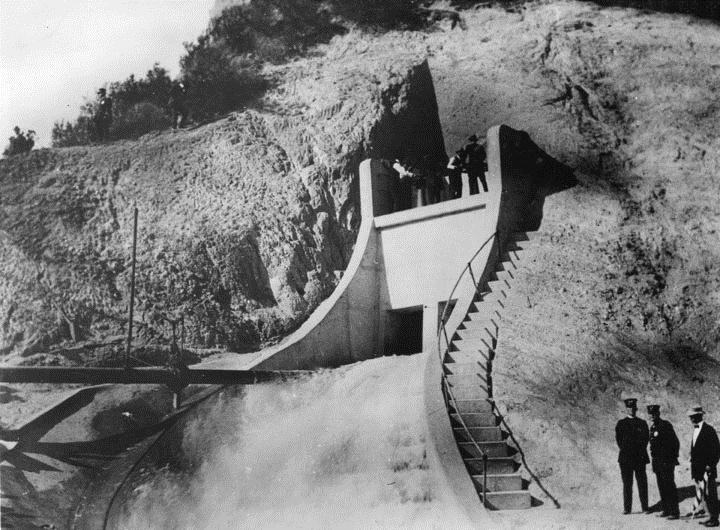 |
|
| (November 5, 1913)* - Official Opening of the water gates of the Los Angeles Aqueduct. |
Click HERE to see more on the Opening of the LA Aqueduct. |
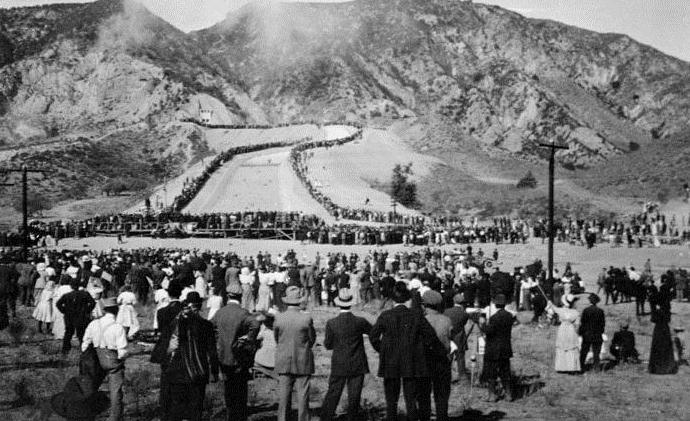 |
|
| (November 5, 1913)* - Crowds watch as the water gates are opened and the Los Angeles Aqueduct water starts to flow down into the San Fernando Valley. William Mulholland, builder of the aqueduct and H. A. Van Norman, Chief Engineer and General Manager, Water Bureau. |
Historical Notes Once Los Angeles had a reliable water supply it began to grow dramatically. Some argue that the city would not be what it is today without the LA Aqueduct. |
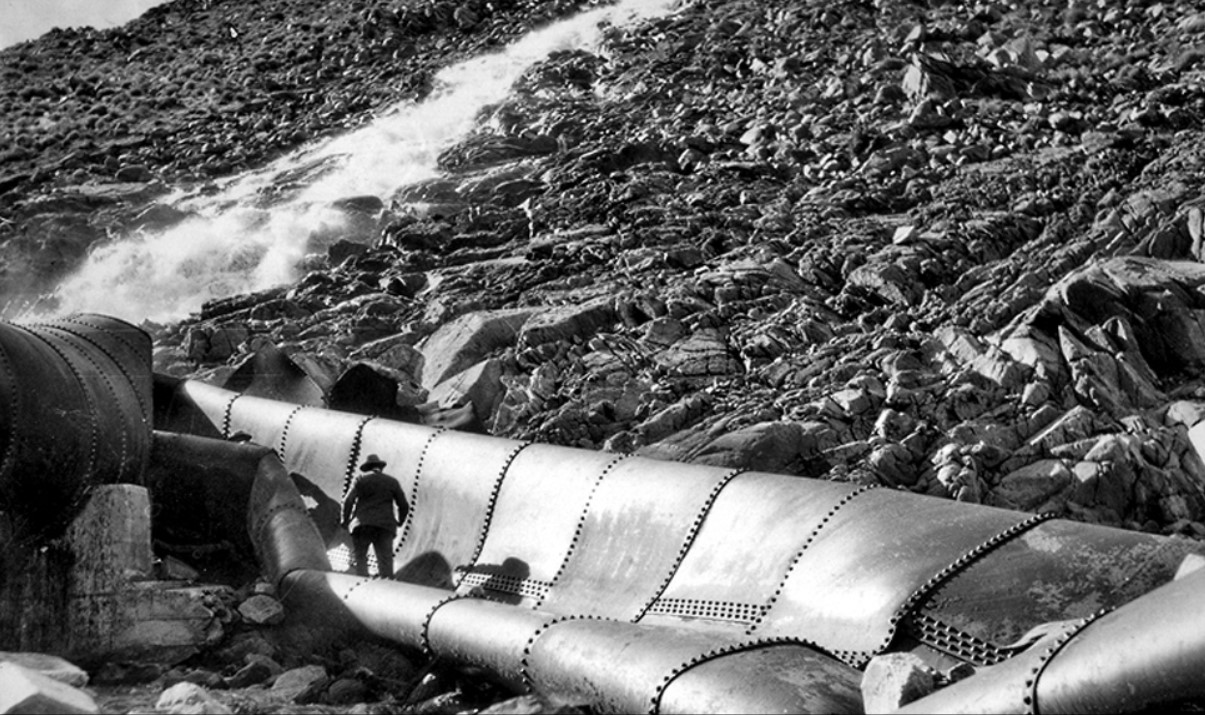 |
|
| (1927)*# – The scene at No Name Canyon after a dynamite attack destroyed 400 feet of pipe on May 27, 1927. |
Historical Notes Owens Valley residents began to fight the City's water export. Confrontations escalated to several dynamitings of the Aqueduct. Much has been written about the water conflict between Owens Valley and the City of Los Angeles and also of the environmental impacts resulting from the LA Aqueduct's construction. The issues are complex and have different points of view. Water and Power Associates recommends several books (as listed at the bottom of page) to gain a better understanding of all the complex issues surrounding the Los Angeles Aqueduct. |
Owens Valley and the City of Los Angeles - A Complex Relationship
“…the businesses and the homes were leased or rented back to the same people (residents of Owens Valley) to pursue their same activity. Most of them did and very successfully. Because, by that time, the impact of the city's improvements in the Owens Valley, and I don't mean the aqueduct, I mean in connection with the construction of the aqueduct, the city built a broad-gauge railroad from Mojave to Long Pine to connect with the narrow gauge railroad. So for the first time the Owens Valley had rail service to ship any products it had, including ranch products out of the city to Los Angeles. The City used its influence with the State of California to have the highway paved from Mojave to the Owens Valley, and that was done. So access to the Owens Valley because of the City's work, in its own behalf obviously, but still it was there and available to anybody that wanted to use it, both the railroad and the highway. The city built power plants in connection with the construction of the aqueduct, and those plants for a long time provided power to the Owens Valley, which didn't have it before the city came in there with the aqueduct construction.
So there were a lot of benefits that occurred that, in my readings and listening to too many people that have no idea that those things happened or don't wish to... admit that those things happened.”
Robert V. Phillips,
Chief Engineer and General Manager of DWP, 1972-75 (Both Mr. Phillips and his father knew and worked with Mulholland and Van Norman).
Read more of an Insightful Interview with Robert V. Phillips:
Los Angeles Aqueduct History and Photos |
Recommended reading about William Mulholland and the history of water in Los Angeles:
William Mulholland and the Rise of Los Angeles
By Catherine Mulholland
The Water Seekers
By Remi Nadeau
Vision or Villainy
By Abraham Hoffman
Beyond Chinatown
By Steven Erie
Cadillac Desert: The American West and Its Disappearing Water
By Marc Reisner
References and Credits
* DWP - LA Public Library Image Archive
^ DWP - The Story of the Los Angeles Aqueduct
^*L.A. Aqueduct Centennial 2013
^# Claremont Colleges Digital Library
*^Wikipedia: California Water Wars; Owens River
< Back
Menu
- Home
- Mission
- Museum
- Mulholland Service Award
- Major Efforts
- Board Officers and Directors
- Positions on Owens Valley and the City of Los Angeles Issues
- Legislative Positions on
Water Issues
- Legislative Positions on
Energy Issues
- Recent Newsletters
- Historical Op Ed Pieces
- Membership
- Contact Us
- Search Index